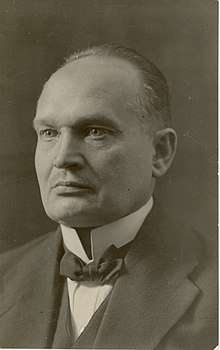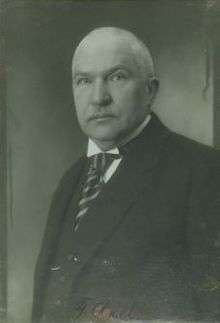Head of State of Estonia
The Head of State of Estonia or State Elder (Estonian: riigivanem) was the official title of the Estonian head of state from 1920 to 1937. He combined some of the functions held by a president and prime minister in most other democracies.
According to the 1920 Estonian Constitution, which was enforced by the “Constitution of the Republic of Estonia, the Referendum Act and the Citizens’s Initiative Act Implementation Act“ on July 2, 1920, after being approved by the Constituent Assembly on June 16, 1920 (Riigi Teataja August 9, 1920 No. 113/114), the Government of the Republic consisted of the riigivanem (Head of State) and Ministers (Section 58).
The responsibilities of the Head of State were representing the Republic of Estonia, administration and co-ordination of the activities of the Government of the Republic, chairing the Government meetings; the Head of State had the right to make inquiries about the activities of the Ministers (Section 62). The Government of the Republic appointed one of its members the Deputy of the Elder of State.
In practice, the Head of State had very little power. The 1920 constitution was radically parliamentarian in character, and the Head of State could be voted out of office at any time. This limited his ability to play a balancing role between the government and the legislature.
With the 1934 constitution, the institution saw a reform and it became the equivalent of a president only as a separate head of government was to be elected. The 1934 coup by Konstantin Päts resulted in the institution never coming to real life as he ruled as the Prime Minister in Duties of the Head of State until 1937.
Heads of State of the Republic of Estonia, 1920–1934
| Portrait | Name | Term of Office | Political Party | Cabinet | Riigikogu (Election) |
Separate Head of State | |||
|---|---|---|---|---|---|---|---|---|---|
| Took Office | Left Office | Days | |||||||
| The 1920 Constitution replaced the office of Prime Minister. | |||||||||
| Ants Piip (1884–1942) 1st State Elder |
20 December 1920 | 25 January 1921 | 37 | Labour Party (ETE) |
Piip ETE |
I (1920) |
None | ||
 |
Konstantin Päts (1874–1956) 2nd State Elder (2nd term, 1st as State Elder) |
25 January 1921 | 21 November 1922 | 666 | Farmers' Assemblies (PK) |
Päts I PK–ETE–ER–KRE PK–ER–KRE | |||
| Juhan Kukk (1885–1942) 3rd State Elder |
21 November 1922 | 2 August 1923 | 255 | Labour Party (ETE) |
Kukk ETE–PK–ER ETE–PK–ER–ESDTP ETE–PK–ESDTP | ||||
 |
Konstantin Päts (1874–1956) 4th State Elder (3rd term, 2nd as State Elder) |
2 August 1923 | 26 March 1924 | 238 | Farmers' Assemblies (PK) |
Päts II PK–KRE–ER–ETE PK–KRE–ER |
II (1923) | ||
 |
Friedrich Karl Akel (1871–1941) 5th State Elder |
26 March 1924 | 16 December 1924 | 266 | Christian People's Party (KRE) |
Akel KRE–ETE–ER | |||
| Jüri Jaakson (1870–1942) 6th State Elder |
16 December 1924 | 15 December 1925 | 365 | People's Party (ER) |
Jaakson ER–PK–ESDTP–ETE–KRE | ||||
| Jaan Teemant (1872-1941?) 7th State Elder |
15 December 1925 | 9 December 1927 | 725 | Farmers' Assemblies (PK) |
Teemant I PK–ETE–KRE–ARVK PK–ETE–KRE–ARVK–RVP | ||||
| Teemant II PK–ARVK–KRE–ER–ÜMSL |
III (1926) | ||||||||
| Teemant III PK–ARVK–ER–KRE–ÜMSL | |||||||||
 |
Jaan Tõnisson (1868-1941?) 8th State Elder (3rd term, 1st as State Elder) |
9 December 1927 | 4 December 1928 | 362 | People's Party (ER) |
Tõnisson III ER–PK–ARVK–ETE | |||
| August Rei (1886–1963) 9th State Elder |
4 December 1928 | 9 July 1929 | 218 | Socialist Workers' Party (ESTP) |
Rei ESTP–ARVK–ETE–KRE | ||||
| Otto August Strandman (1875–1941) 10th State Elder (2nd term, 1st as State Elder) |
9 July 1929 | 12 February 1931 | 584 | Labour Party (ETE) |
Strandman II ETE–ARVK–PK–KRE–ER |
IV (1929) | |||
 |
Konstantin Päts (1874–1956) 11th State Elder (4th term, 3rd as State Elder) |
12 February 1931 | 19 February 1932 | 373 | Farmers' Assemblies (PK) |
Päts III PK–ER–ESTP | |||
| Jaan Teemant (1872-1941?) 12th State Elder (2nd term, 2nd as State Elder) |
19 February 1932 | 19 July 1932 | 152 | Farmers' Assemblies and Association of Settlers (PK/ARVK) |
Teemant IV PK/ARVK–RKE | ||||
| Karl August Einbund (later Kaarel Eenpalu) (1888–1942) 13th State Elder |
19 July 1932 | 1 November 1932 | 106 | Farmers' Assemblies and Association of Settlers (PK/ARVK) |
Einbund I PK/ARVK–RKE |
V (1932) | |||
 |
Konstantin Päts (1874–1956) 14th State Elder (5th term, 4th as State Elder) |
1 November 1932 | 18 May 1933 | 199 | Farmers' Assemblies and Association of Settlers (PK/ARVK) |
Päts IV PK/ARVK–RKE–ESTP | |||
 |
Jaan Tõnisson (1868-1941?) 15th State Elder (4th term, 2nd as State Elder) |
18 May 1933 | 21 October 1933 | 157 | National Centre Party (RKE) |
Tõnisson IV RKE–ARVK | |||
 |
Konstantin Päts (1874–1956) 16th State Elder (6th term, 5th as State Elder) |
21 October 1933 | 24 January 1934 | 96 | Farmers' Assemblies and Association of Settlers (PK/ARVK) |
Päts V non-party coalition | |||
| The 1934 Constitution divided the office of State Elder between a new office called State Elder and a Prime Minister. | |||||||||
Head of State of the Republic of Estonia, 1934–1937
| Portrait | Name | Term of Office | Political Party | Cabinet | Riigikogu (Election) |
Separate Head of Government | |||
|---|---|---|---|---|---|---|---|---|---|
| Took Office | Left Office | Days | |||||||
| The 1934 Constitution divided the office of State Elder between a new office called State Elder and a Prime Minister. | |||||||||
 |
Konstantin Päts (1874–1956) 6th Prime Minister (in duties of the State Elder) (6th term) |
24 January 1934 | 3 September 1937 | 1,319 | Farmers' Assemblies and Association of Settlers (PK/ARVK) [Note 1] |
Päts V non-party coalition |
V (1932) |
Prime Minister in duties of the State Elder Konstantin Päts | |
| Fatherland Union (I) [Note 2] |
Parliament disbanded [Note 3] | ||||||||
| The Amendment Act of the 1938 Constitution temporarily merged the offices of State Elder and Prime Minister into President-Regent. | |||||||||
See also
Notes
- All political parties were banned on 20 March 1935.
- The Fatherland Union was the only sanctioned political organization, but cannot be considered a political party per se.
- The "Era of Silence" began on with Päts' self-coup on 21 March 1934. The Riigikogu approved of the coup retroactively on 15 March 1934. The Riigikogu was thereafter not convened after 2 October 1934. It was officially disbanded on 1 October 1938.